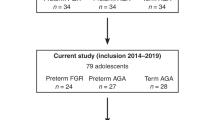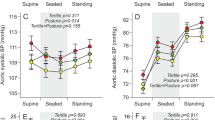Abstract
Preterm, very-low-birth-weight neonates (≤1500 gm, VLBW) exhibit elevated systolic blood pressures (SBP) in adolescence and adulthood; however, the age of onset and causes are unknown. We assessed SBP in a cross-sectional study of VLBW infants at 1, 2 and 3 years of age (n = 40 per cohort). SBP was manually measured using Doppler amplification (observed), and calm values were compared to reference ranges used for clinical purposes (expected). SBP was converted to age-, gender- and height-specific z-scores (SBPz). Perinatal variables and growth parameters measured between 6 and 36 months were assessed as predictors of an elevated SBP. Observed SBP and SBPz exceeded the expected value at each age (P < 0.01); for example 1 year SBP was 94 ± 10 (standard deviation) vs. 85 ± 3 mmHg, respectively. Although the expected SBP rose from 85 ± 3 to 90 ± 3 mmHg with advancing age (P < 0.05), VLBW SBP was unchanged (P > 0.1), averaging 93 mmHg across ages. Height and weight z-scores were below expected (P < 0.01), while weight-for-height z-scores exceeded zero at 6, 12 and 24 months (P < 0.05). Male subscapular skinfold thickness:abdominal circumference ratio decreased with advancing age, paralleling the decreases in SBPz. The VLBW neonates demonstrated an elevated SBP as early as 1 year of age. Although predictive perinatal variables were not identified, gender-specific relationships between infant growth and SBP were observed.
Similar content being viewed by others
References
Barker DJP (1995) Fetal origins of coronary heart disease. Br Med J 311:171–174
Nilsson PM, Ostergren PO, Nyberg P, Soderstrom M, Allebeck P (1997) Low birth weight is associated with elevated systolic blood pressure in adolescence: a prospective study of a birth cohort of 149, 378 Swedish boys. J Hypertens 15:1627–1631
Barker DJP, Osmond C, Forsén TJ, Kajantie E, Eriksson JG (2005) Trajectories of growth among children who have coronary events as adults. N Engl J Med 353:1802–1809
Hardy R, Wadsworth ME, Langenberg C, Kuh D (2004) Birthweight, childhood growth, and blood pressure at 43 years in a British birth cohort. Int J Epidemiol 33:121–129
Eriksson JG (2007) Epidemiology, genes and the environment: lessons learned from the Helsinki Birth Cohort Study. J Intern Med 261:418–425
Belfort MB, Rifas-Shiman SL, Rich-Edwards J, Kleinman KP, Gillman MW (2007) Size at birth, infant growth, and blood pressure at three years of age. J Pediatr 151:670–674
Siewert-Delle LS (1998) The impact of birth weight and gestational age on blood pressure in adult life. A population-based study of 49-year-old men. Am J Hypertens 11:946–953
Johansson S, Thadou A, Bergvall N, Tuvemo T, Noramn M, Cnattinhius S (2005) Risk of high blood pressure among young men increases with the degree of immaturity at birth. Circulation 112:3430–3436
Bonamy AE, Bendito A, Martin H, Andolf E, Sedin G, Norman M (2005) Preterm birth contributes to increased vascular resistance and higher blood pressure in adolescent girls. Pediatr Res 58:845–849
Hack M, Schluchter M, Cartar L, Rahman M (2005) Blood pressure among very low birth weight (<1.5 kg) young adults. Pediatr Res 58:677–684
Keijzer-Veen MG, Finken MJ, Nauta J, Dekker FW, Hille ET, Frölich M, Wit JM, van der Heijden AJ, Dutch POPS-19 Collaborative Study Group (2005) Is blood pressure increased 19 years after intrauterine growth restriction and preterm birth? A prospective follow-up study in the Netherlands. Pediatrics 116:725–731
(2004) National High Blood Pressure Education Program Working Group on High Blood Pressure in Children and Adolescents:The Fourth Report on the diagnosis, evaluation and treatment of high blood pressure in children and adolescents. Pediatrics 144:555–576
Duncan AF, Rosenfeld CR, Morgan JS, Ahmad HRJ (2008) Interrater reliability and effect of state on blood pressure measurements in infants 1 to 3 years of age. Pediatrics 122:e590–e594
Whyte RK, Elseed AM, Fraser CB, Shinebourne EA, de Swiet M (1975) Assessment of Doppler ultrasound to measure systolic and diastolic blood pressures in infants and young children. Arch Dis Child 50:542–544
Butani L, Morgenstern B (2003) Are pitfalls of oscillometric blood pressure measurements preventable in children? Pediatr Nephrol 18:313–318
He J, Whelton PK (1999) Elevated systolic blood pressure and risk of cardiovascular and renal disease: Overview of evidence from observational epidemiologic studies and randomized controlled trials. Am Heart J 138:S211–S219
Berenson GS, McMahan CA, Voors AW, Webber LS, Frank GC, Foster TA, Blonde CV (1980) Cardiovascular risk factors in children: the early natural history of atherosclerosis and essential hypertension. Oxford University Press, New York
Gutgesell M, Terrell G, Labarthe D (1981) Pediatric blood pressure: ethnic comparison in a primary care center. Hypertension 3:39–49
Rosner B, Prineas RJ, Loggie JMH, Daniels SR (1993) Blood pressure nomograms for children and adolescents, by height, sex, and age in the United States. J Pediatr 123:871–886
Schacter J, Kuller LH, Perfetti C (1984) Blood pressure during the first five years of life: relation to ethnic group (black or white) and to parental hypertension. Am J Epidemiol 119:541–553
Zinner SH, Rosner B, Oh WO, Kass EH (1985) Significance of blood pressure in infancy. Hypertension 7:411–416
World Health Organization (WHO) (2007) WHO Anthro for Personal Computers, version 2. Software for assessing growth and development of the world’s children. World Health Organization, Geneva
WHO Multicentre Growth Reference Study Group (2007) WHO child growth standards: Head circumference-for-age, arm circumference-for-age, triceps skinfold-for-age and subscapular skinfold-for-age: methods and development. World Health Organization, Geneva
WHO Multicentre Growth Reference Study Group (2006) WHO child growth standards: length/height-for-age, weight-for-age, weight-for-length, weight-for-height and body mass index-for-age: methods and development. World Health Organization, Geneva
de Onis M, Garza C, Onyango AW, Martorell R (2006) WHO Child growth standards. Acta Paediatr 95[Suppl 450]:76–85
Tabachnick BG, Fidell LS (1996) Using multivariate statistics, 3rd edn. Harper Collins College Publ, New York
Kanai H, Matsuzawa Y, Kotani K, Keno Y, Kobatake T, Nagai Y, Fujioka S, Tokunaga K, Tarui S (1990) Close correlation of intra-abdominal fat accumulation to hypertension in obese women. Hypertension 16:484–490
Ll N, Laaksonen DE, Nyyssönen K, Punnonen K, Valkonen V, Fuentes R, Tuomainen T, Salonen R, Salonen JT (2004) Inflammation, abdominal obesity, and smoking as predictors of hypertension. Hypertension 44:859–865
Snijder MB, Zimmet PZ, Visser M, Dekker JM, Seidell JC, Shaw JE (2004) Independent and opposite associations of waist and hip circumferences with diabetes, hypertension and dyslipidemia: the AusDiab Study. Int J Obes 28:402–409
Irving RJ, Belton NR, Elton RA, Walker BR (2000) Adult cardiovascular risk factors in premature babies. Lancet 355:2135–2136
Task Force on Blood Pressure Control in Children (1987) Report of the Second Task Force on Blood Pressure Control in Children. Pediatrics 79:1–25
Bracewell MA, Hennessy EM, Wolke D, Marlow (2008) The EPICure study: growth and blood pressure at 6 years of age following extremely preterm birth. Arch Dis Child Fetal Neonatal Ed 93:F108-F114
Zubrow AB, Hulman S, Kushner H, Falkner B (1995) Determinants of blood pressure in neonates admitted to neonatal intensive care units: a prospective multicenter study. J Perinatol 15:470–479
LaFlore JL, Engle WD, Rosenfeld CR (2000) Determinants of blood pressure in very low birth weight neonates: lack of effect of antenatal steroids. Early Hum Dev 59:37–50
Georgieff MK, Mills MM, Gomez-Marin O, Sinaiko AR (1996) Rate of change in blood pressure in premature and full term infants from birth to 4 months. Pediatr Nephrol 10:152–155
Rodriguez MM, Gomez AH, Abitbol CL, Chandar JJ, Duara S, Zilleruelo GE (2004) Histomorphometric analysis of postnatal glomerulogenesis in extremely preterm infants. Pediatr Dev Pathol 7:17–25
Bagby SP (2009) Developmental origins of renal disease: Should nephron protection begin at birth? Clin J Am Soc Nephrol 4:10–13
Hodgin JB, Rasoulpour M, Markowitz GS, D’Agati VD (2009) Very low birth weight is a risk factor for secondary focal segmental glomerulosclerosis. Clin J Am Soc Nephrol 4:71–76
Acknowledgments
Dr. Duncan received funding from a Marshall Klaus Research Award from the American Academy of Pediatrics, Section on Perinatal Pediatrics; additional support was provided by the George L. MacGregor Professorship awarded to Dr. Rosenfeld.
Author information
Authors and Affiliations
Corresponding author
Rights and permissions
About this article
Cite this article
Duncan, A.F., Heyne, R.J., Morgan, J.S. et al. Elevated systolic blood pressure in preterm very-low-birth-weight infants ≤3 years of life. Pediatr Nephrol 26, 1115–1121 (2011). https://doi.org/10.1007/s00467-011-1833-x
Received:
Revised:
Accepted:
Published:
Issue Date:
DOI: https://doi.org/10.1007/s00467-011-1833-x




